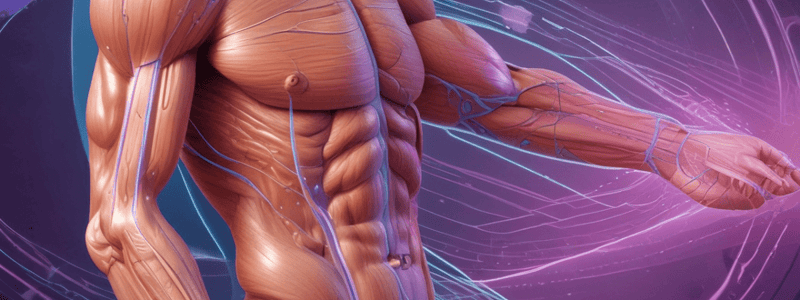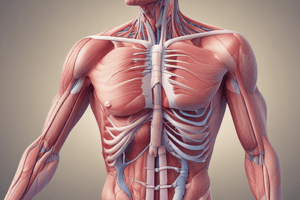Podcast
Questions and Answers
What is the characteristic shape of smooth muscle cells?
What is the characteristic shape of smooth muscle cells?
- Rectangular
- Oval
- Cylindrical
- Small and spindle shaped (correct)
Where is the nucleus located in a smooth muscle cell?
Where is the nucleus located in a smooth muscle cell?
- At the tapered end
- At the periphery
- In the center (correct)
- At the thicker end
What is the appearance of smooth muscle cells under a microscope?
What is the appearance of smooth muscle cells under a microscope?
- Granular
- Fibrous
- Striped
- Smooth and homogenous (correct)
How do smooth muscle cells compare to skeletal and cardiac muscle cells in terms of shortening?
How do smooth muscle cells compare to skeletal and cardiac muscle cells in terms of shortening?
What is a key feature of individual smooth muscle cells?
What is a key feature of individual smooth muscle cells?
What is the characteristic organization of visceral smooth muscle cells?
What is the characteristic organization of visceral smooth muscle cells?
Which of the following organs is typically composed of multi-unit smooth muscle?
Which of the following organs is typically composed of multi-unit smooth muscle?
What type of smooth muscle is typically found in the walls of the bladder?
What type of smooth muscle is typically found in the walls of the bladder?
Which of the following is NOT an example of an organ containing visceral smooth muscle?
Which of the following is NOT an example of an organ containing visceral smooth muscle?
What is the main difference between visceral and multi-unit smooth muscle?
What is the main difference between visceral and multi-unit smooth muscle?
What is unique about the contractions of uterine muscle?
What is unique about the contractions of uterine muscle?
What is the characteristic pattern of movement in smooth muscle?
What is the characteristic pattern of movement in smooth muscle?
How does the central nervous system (CNS) influence smooth muscle contractions?
How does the central nervous system (CNS) influence smooth muscle contractions?
What is the organizational structure of smooth muscle cells?
What is the organizational structure of smooth muscle cells?
What is the primary difference between smooth muscle contractions and skeletal muscle contractions?
What is the primary difference between smooth muscle contractions and skeletal muscle contractions?
Uterine muscle contractions can be controlled voluntarily.
Uterine muscle contractions can be controlled voluntarily.
Smooth muscle cells have a striped appearance under the microscope.
Smooth muscle cells have a striped appearance under the microscope.
Uterine muscle contractions are modified by the peripheral nervous system.
Uterine muscle contractions are modified by the peripheral nervous system.
Smooth muscle contractions are typically strong and fine.
Smooth muscle contractions are typically strong and fine.
Hormone stimulation decreases uterine muscle contractions.
Hormone stimulation decreases uterine muscle contractions.
What is the primary function of smooth muscle contractions in the gastrointestinal tract?
What is the primary function of smooth muscle contractions in the gastrointestinal tract?
How do visceral smooth muscle cells react to stretching?
How do visceral smooth muscle cells react to stretching?
What is unique about the nerve supply of uterine muscle?
What is unique about the nerve supply of uterine muscle?
What is the characteristic of smooth muscle contractions in terms of strength?
What is the characteristic of smooth muscle contractions in terms of strength?
What is the role of hormone stimulation in uterine muscle contractions?
What is the role of hormone stimulation in uterine muscle contractions?
What is the characteristic pattern of contraction in visceral smooth muscle?
What is the characteristic pattern of contraction in visceral smooth muscle?
What is the role of the central nervous system in smooth muscle contractions?
What is the role of the central nervous system in smooth muscle contractions?
What is the effect of stretching on visceral smooth muscle contractions?
What is the effect of stretching on visceral smooth muscle contractions?
What is the term for the wave-like movement of muscles in a tube, such as the intestines?
What is the term for the wave-like movement of muscles in a tube, such as the intestines?
What is unique about the contractions of uterine muscle compared to other smooth muscles?
What is unique about the contractions of uterine muscle compared to other smooth muscles?
Visceral smooth muscle contractions are controlled by the autonomic nervous system.
Visceral smooth muscle contractions are controlled by the autonomic nervous system.
Smooth muscle contractions are typically weak and fine.
Smooth muscle contractions are typically weak and fine.
Peristalsis is a voluntary movement of muscles in a tube.
Peristalsis is a voluntary movement of muscles in a tube.
The central nervous system has no influence on smooth muscle contractions.
The central nervous system has no influence on smooth muscle contractions.
Smooth muscle cells have a similar structure to skeletal muscle cells.
Smooth muscle cells have a similar structure to skeletal muscle cells.
Cardiac muscle cells typically have multiple nuclei.
Cardiac muscle cells typically have multiple nuclei.
Cardiac muscle forms simple networks around chambers of the heart.
Cardiac muscle forms simple networks around chambers of the heart.
The structure of cardiac muscle cells is similar to skeletal muscle cells.
The structure of cardiac muscle cells is similar to skeletal muscle cells.
Cardiac muscle cells are found in the walls of the bladder.
Cardiac muscle cells are found in the walls of the bladder.
Cardiac muscle cells are able to contract voluntarily.
Cardiac muscle cells are able to contract voluntarily.
Cardiac muscle cells are only found in the heart.
Cardiac muscle cells are only found in the heart.
Each cardiac muscle cell typically has multiple nuclei.
Each cardiac muscle cell typically has multiple nuclei.
Cardiac muscle cells can generate an action potential without an external stimulus.
Cardiac muscle cells can generate an action potential without an external stimulus.
Cardiac muscle cells contract in response to external stimulation only.
Cardiac muscle cells contract in response to external stimulation only.
Cardiac muscle cells contract at different rhythms depending on the cell.
Cardiac muscle cells contract at different rhythms depending on the cell.
What is unique about the sinoatrial node in the heart?
What is unique about the sinoatrial node in the heart?
What is the characteristic of cardiac muscle contraction?
What is the characteristic of cardiac muscle contraction?
How do cardiac muscle cells contract in relation to each other?
How do cardiac muscle cells contract in relation to each other?
What is the structure of cardiac muscle cells?
What is the structure of cardiac muscle cells?
When do cardiac muscle cells start generating an action potential?
When do cardiac muscle cells start generating an action potential?
Flashcards are hidden until you start studying
Study Notes
Microscopic Anatomy of Smooth Muscle
- Smooth muscle cells are small and spindle-shaped, tapering at the ends.
- They have a single nucleus in the center and a smooth, homogeneous appearance under the microscope with no striations.
- Individual smooth muscle cells can shorten to a greater extent than skeletal or cardiac muscle cells.
Types of Smooth Muscle
- Visceral smooth muscle: found in large sheets of cells in the walls of some hollow organs, such as the stomach, bladder, uterus, small intestine, and colon.
- Multi-unit smooth muscle: found in small discrete groups of cells, such as in the eyes, blood vessels, and lungs.
Function of Smooth Muscle
- Involuntary contractions, not under conscious control.
- Contractions can be strong.
- Formed as large sheets of muscle that move in waves of contraction rather than fine movement.
- Uterine muscle is different, with contractions increasing due to hormone stimulation.
- Has its own nerve supply to modify contractions, controlled by the CNS.
Visceral Smooth Muscle
- Contracts without the need for external stimulation.
- Reacts to stretching by contracting more strongly, which is useful in the gastrointestinal tract.
- Peristalsis: involuntary contraction and relaxation of muscles down a tube (e.g., intestines) that creates a wave-like movement.
Cardiac Muscle
- Branched cardiac muscle cells form elaborate networks around chambers of the heart.
- Each cell usually has one nucleus.
- Found only in the heart.
- Sinoatrial node starts contraction, but also capable of intrinsic contraction.
- Specialized cells can generate an action potential without an external stimulus.
- Starts heart beating before an animal is born.
Function of Cardiac Muscle
- Involuntary contraction, no thought is required to make it work.
- Contracts rhythmically with no external stimulation, unique to cardiac muscle.
- All cardiac muscle cells contract at the same rhythm, adopting the contraction rate of the fastest cell in the group.
- Controlled by the heart's own impulse conduction system.
Studying That Suits You
Use AI to generate personalized quizzes and flashcards to suit your learning preferences.




